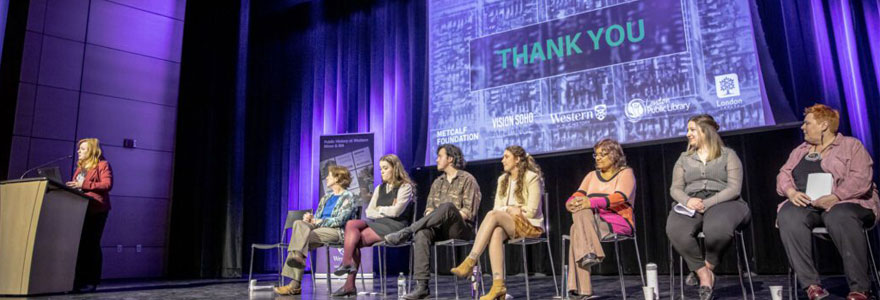News and Updates
Contact
Faculty of Social Science
Social Science Centre
Room 9438
Western University
T. 519-661-2053
F. 519-661-3868
E. social-science@uwo.ca
Public History project documents historic neighbourhood in heart of London, Ont.
April 11, 2023
Western graduate students who participated in the project speak about the findings of their research. (Christopher Kindratsky/Western Communications photo); story by Rob Rombouts
A community engagement project by a group of Western graduate students has become, in the course of three years, an organic discovery of the human stories at the heart of a London, Ont. neighbourhood.
In 2021, the Vision SoHo Alliance, a partnership among non-profit housing developers, contacted history professor Michelle Hamilton, requesting her help to discover and tell the diverse stories defining the SoHo neighbourhood (a contraction of ‘South of Horton’).
The Alliance is building 680 units of mixed-income housing on five acres of land bounded by Waterloo, Colborne, South and Hill Streets, and space that was once home to Victoria Hospital and other related medical buildings. The neighbourhood now known as SoHo, previously called St. David’s Ward, has a rich past, as a landing place for many immigrants to London, and as a base of the city’s industrial past.
Western’s public history program has been engaged in community connection since it was established in 1986. This project was an opportunity for the students in the program to bring the history of the community to life. In the process, the students could help turn the new developments into a vibrant home, with its own heritage and milestones, with which future tenants could connect.
“Good public history means collaborating with the community and creating a product that lives beyond the classroom. The invitation by the Vision SoHo Alliance to research the neighbourhood including the role of Victoria Hospital and to curate outdoor historical signs for future tenants of its seven apartment buildings is a phenomenal one,” said Hamilton.
“It tasked us to present the history of the site in a way that is meaningful to the new tenants, in order to give them a sense of community and motivation to invest in their new homes.”
On April 3, Hamilton and the 2022-23 cohort of the MA in public history program presented their research at the Wolf Performance Hall at the London Public Library. Members of the local community joined in person and online, engaging with the stories and the history of SoHo. Each speaker integrated personal stories and oral history elements into their presentation, using the vignettes to highlight the particular aspect of the history they had researched.
Hamilton spoke about the Indigenous history of the area and MA student Jessica Hugh talked about the industrial history of the neighbourhood. With three railways running through the area, many manufacturers set up shop in SoHo. Notably, the neighbourhood was home to Labatt, which would go on to be the largest brewer in Canada.
MA student Niġel Klemenčič-Puglisevich spoke about the immigrant experience in the area. SoHo, he said was “a haven for various migrant groups,” including Irish, Italian, Maltese, Syrian and Lebanese communities. These groups, and others, brought languages and culture that contribute to cultural richness and diversity of the neighbourhood.”
Student Hannah Mantel spoke on SoHo’s Jewish community and about the impact and experiences of the neighbourhood in the First and Second World Wars.
Zahra McDoom and Sarah Pointer spoke about the Black history of the neighbourhood and London. Much of the early life of the Black community in the city was centered in SoHo, and well-known people, including the Ball family and performer Joey Hollingsworth called the neighbourhood home.
Kathrine-Mackenzie Bodnar spoke about the history of the medical buildings and institutions in SoHo, and their connections with the community.
“It’s heartening to know some of the very walls that once housed these institutions will now be re-purposed to serve an equally vital community need, affordable housing,” Bodnar said. “This project will provide a new chapter in the history of this neighbourhood, ensuring it remains a vibrant and thriving community for years to come.”
Community interest and involvement has been crucial in collecting the stories, and will be important in the continued success of the project. Hamilton said many community members spoke with the presenters afterwards.
“London heritage workers said they learned new historical information, while others offered to tell us more stories about life in SoHo.”
“We couldn’t have conducted such good research without the participation of all those who agreed to give oral history interviews,” said Hamilton. “Their response to our call for stories overwhelmed us. Almost 100 individuals have contacted us so far.”
The next phase of the project will focus on creating the signs to be installed once the development is complete.

